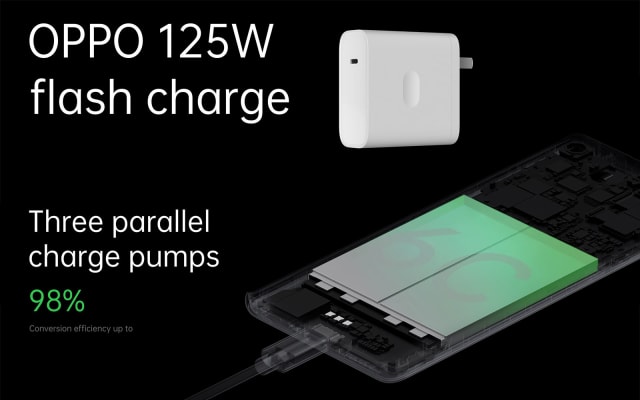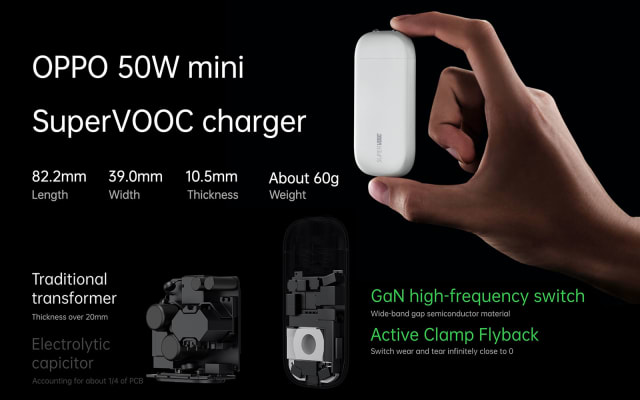
Oppo
To ensure a safe and stable charge, the phone’s temperature is kept below 40 ° C or 104 ° F (in a constant environment of 25 ° C or 77 ° F), courtesy of the charger’s built-in semiconductor cooling system (taking advantage of the Peltier effect) under the coils. Apparently, this is more effective than sending air to the phone like many other fast wireless chargers do.
That said, there is also a fan in the charger base to suck air in from the top of the charging board (thereby dissipating heat from the semiconductor system), as well as to cool the management circuit in the charger base, with the hot air blown out from the back of the base. There are other security measures, such as foreign object detection, along with the usual quintuple security protection of VOOC technology.

Oppo
In addition to its latest advancement in wireless charging, Oppo also introduced 125W (20V / 6.25A) flash charging technology (not based on VOOC in this rating; more on that later). This charges a 4,000 mAh battery from zero to 41 percent in just five minutes, or from zero to 100 percent in just 20 minutes. It may sound less attractive than Vivo’s 15-minute charge with its 120W Super FlashCharge, but it’s still 10 minutes faster than Oppo’s own 65W SuperVOOC 2.0, which is already impressive with its 30 minutes.
Despite this increase in charging power, Oppo claims that this new “6C” battery will maintain 80 percent capacity after 800 cycles, thanks to its improved structure and optimized charging algorithms. In terms of security measures, this 125W flash charging design also keeps the phone temperature below 40 ° C or 104 ° F, and this is monitored by a total of 13 sensors inside the phone (and one in the charger). Hardware encryption is in place to ensure that only certified cables can receive the maximum available current.
The new charger carries a USB Type-C interface (finally, a first for Oppo), and also features three parallel charging pumps (each with 42W of power) to convert power from 20V / 6.25A to 10V / 12.5A. for battery, with a conversion efficiency of up to 98 percent. Thanks to tighter component integration and tighter temperature control, this charger is slightly larger than the existing 65W SuperVOOC 2.0 charger.
Although this charger only makes PPS (programmable power supply, a protocol by USB-IF) for full 125W delivery, it is also capable of 65W SuperVOOC or 30W VOOC, which benefit from low voltage and therefore thermal properties. lower. In addition to that, you also get 65W USB-PD and 36W QC here.

Oppo
Oppo did not stop there. The company also decided to work on miniaturizing its chargers, resulting in this 50W SuperVOOC mini charger. Thanks to a new topological design without bulky electrolytic capacitors, this new GaN charger is about the size of a business card holder, so it can easily be stored in a pocket. When used with a SuperVOOC compatible phone, this device can fully charge a 4,000 mAh battery in 42 minutes, which isn’t too bad. Better yet, this charger also supports other protocols like 27W PD and 50W PPS, which means it can improve some laptops and tablets.
With a similar design, Oppo also built a 110W mini flash charger, which is impressive given that it is roughly the same size as a conventional 18W charger. Through its 110W PPS protocol, this device can charge a 4,000 mAh battery in just 20 minutes, though it likely has a slower initial charge rate than the 125W charger mentioned above. Like its 125W equivalent, the charger is also compatible with Oppo’s own 65W SuperVOOC and 30W VOOC, along with 65W PD and 36W quality control.

Oppo
To date, Oppo has more than 30 smartphones with some form of VOOC flash charging, and apparently more than 157 million users have been using this technology. It is unknown when any of these new charging technologies will enter the market, but given the above patterns, we are likely to see a related announcement as soon as next month. However, other ambitious smartphone brands may come up with something even better, especially when the next wave of 5G phones is about to become even more affordable and aggressive.
